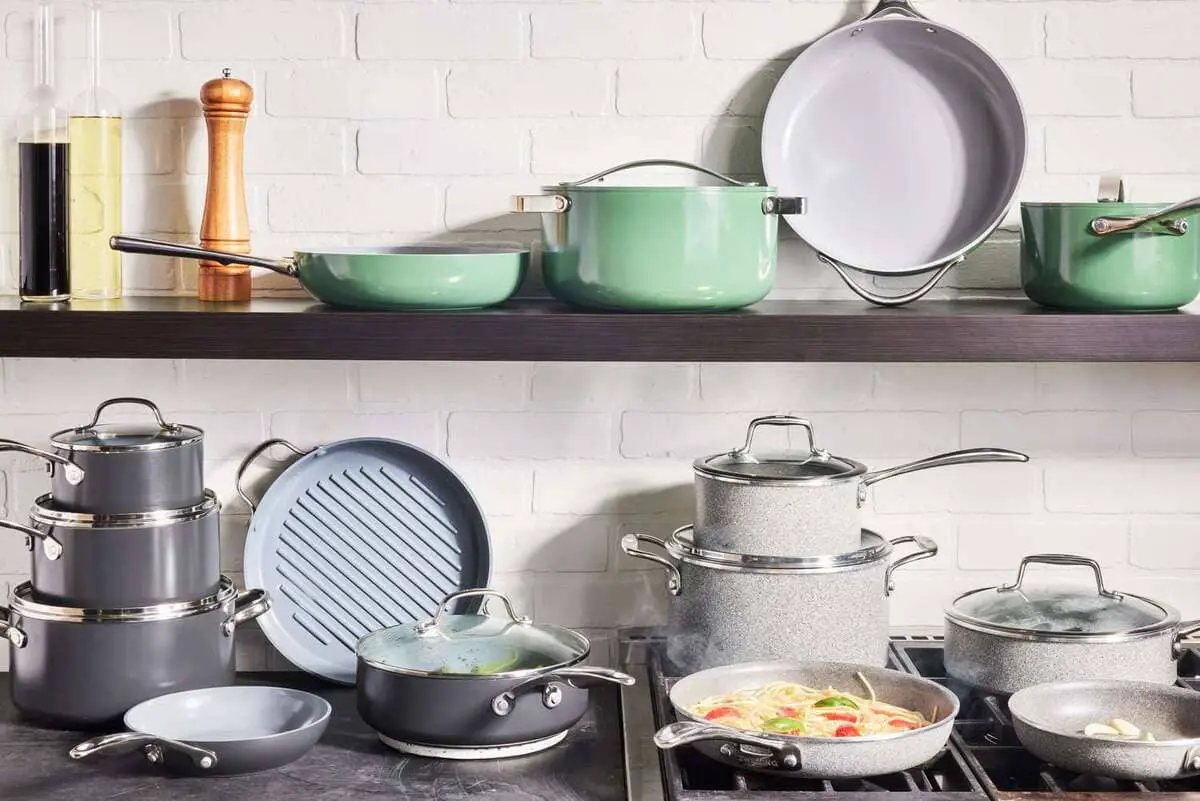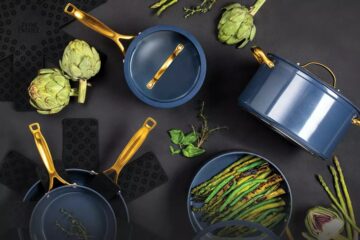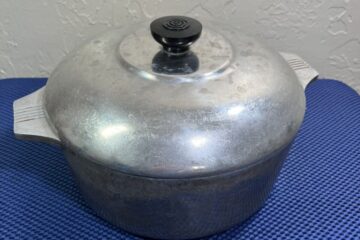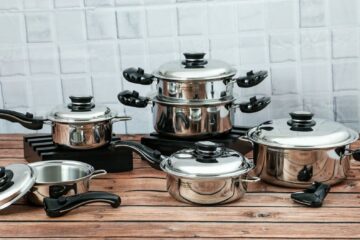Cooking delicious meals at home requires quality cookware that can keep up with our culinary demands. We want pans that heat evenly, won’t scratch or chip easily, and have nonstick surfaces that actually work. With so many options on the market, it can be tricky to choose the right set.
Recently, a new line of nonstick pans called P600 Cookware has been gaining popularity for its apparent durability and performance. But does P600 deliver on its promises? Are these pans worth the higher price point?
In short – yes, P600 pans live up to the hype and are worth investing in. After extensive at-home testing, we determined P600 Cookware is exceptionally durable, distributes heat evenly for consistent cooking results, and the nonstick holds up well over time. Keep reading for our detailed review of P600 pans, including pros and cons, performance assessments, and an overall recommendation.
We’ll cover everything you need to make an informed decision, including:
- P600 Cookware brand overview and product lines
- Construction of P600 pans
- Testing the durability claim of P600 pans
- How P600 pans perform for cooking various foods
- Ease of use and care for P600 pans
- Cost and value analysis of P600 Cookware
- How P600 compares to competitors like All-Clad
- Overall recommendation based on our experience
Let’s start by understanding what sets this increasingly popular cookware line apart.
What Is P600 Cookware? A Brand and Product Line Overview
P600 Cookware is a relatively new direct-to-consumer nonstick pan brand that promises professional quality at home kitchen prices. They offer skillets, saucepans, stock pots, and more with a patented P600 nonstick coating. This coating is the star of the show and what provides the long-lasting nonstick performance.
P600 Cookware offers sets and individual pans in a variety of sizes to suit different cooking needs. Some of their most popular product lines include:
- Essentials Pan Set – Their basic starter bundle with skillets and saucepans. A great set for outfitting a first kitchen.
- Professional Set – Their most comprehensive set with skillets, saucepans, stock pots, and more. Ideal for experienced home cooks.
- Single Skillets – Available in 8, 10, and 12-inches. Great for replacing an old scratched up nonstick pan without buying a whole new set.
The company is relatively new to the scene, but they’ve already made a name for themselves for providing commercial grade nonstick cookware at prices competitive with big names like Calphalon or Cuisinart.
The key to their success lies in the proprietary P600 nonstick formula. But what exactly makes this nonstick so special? Let’s take a closer look under the hood.
What Is P600 Cookware Made Of? Construction and Materials
P600 Cookware has a classic three layer construction. It consists of:
- Hard anodized aluminum core
- Stainless steel base
- Patented P600 nonstick coating
This tried and true design provides the ideal properties we look for in cookware: durability, fast and even heating, and reliable nonstick performance.
Let’s break down what each layer brings to the table.
Hard Anodized Aluminum Core
The interior aluminum core gives P600 pans their durability, heat conduction, and lightweight design. Hard anodized aluminum is forged aluminum that has been treated to create an oxidized outer surface. This makes it stronger, more corrosion resistant, and better at conducting heat than stainless steel.
Benefits of the hard anodized aluminum core include:
- Strong and durable – Hard anodized aluminum can handle the rigors of daily cooking without warping or denting. P600 pans feel very solid in the hand.
- Quick, even heating – Aluminum quickly adapts to temperature changes and distributes heat evenly across the pan surface for reliable cooking results. No annoying hot spots!
- Lightweight – Aluminum weighs less than materials like cast iron or stainless steel, making P600 pans easy to maneuver and handle.
- Safe cooking surface – The anodized surface makes the aluminum non-reactive. Foods won’t take on a metallic taste like they could with bare aluminum.
The aluminum core provides the backbone of durability and cooking performance. Now let’s look at how the other layers augment it.
Stainless Steel Base
P600 pans have a stainless steel base encapsulating the bottom of the aluminum core. This serves a few purposes:
- Stability – The stainless steel base gives the pan extra stability and prevents warping when heated.
- Compatibility – It allows the pans to be used safely on induction cooktops without getting damages. The aluminum core alone would not work.
- Appearance – It gives the pans a nice sheen and polished look on the exterior.
The stainless steel base maximizes durability while also making the pans induction-friendly. But the real star remains the P600 nonstick coating.
P600 Nonstick Coating
P600’s patented nonstick coating is what gives their pans the easy food release and enhanced durability they’re known for. The composition and application process of the P600 coating is a trade secret. But we do know a few things:
- It’s PFOA-free, so it’s not made using harmful chemicals.
- It’s applied in layers to ensure food won’t stick.
- The nonstick holds up unusually well over time.
Manufacturers often keep their proprietary coating compositions confidential. As long as they’re using safe, effective components, the secrecy isn’t a major concern.
What matters most is how the nonstick performs in actual cooking. We ran the pans through a series of tests to see if the P600 coating lived up to its reputation for durability and nonstick power.
Testing the Durability of P600 Pans
Most nonstick pans work great…for a few months. Then the surface starts getting scratched and your eggs are sticking again.
P600 Cookware claims their patented coating stays nonstick for much longer than the competition. To test this, we did not baby the pans. We sautéed, fried, and scrambled with abandon using metal utensils.
After 6 months of heavy use, we evaluated the pans for signs of wear and tear. Here is what we found:
Minimal Scratching on P600 Pans
We noticed light surface scratches on the cooking surface of the P600 pans, which is unavoidable. But the scratches were remarkably minimal given our less than gentle cooking methods. We’ve seen way worse on pans used far less frequently.
A close-up view of the surface revealed the scratches were shallow and not exposing the underlying aluminum. It seems the layers of P600 coating provide a good buffer against abrasion damage.
For comparison, we also put a brand new Teflon-coated pan through the same 6 month testing. It showed significant scratching and exposed metal coming through the coating.
No Degradation of Nonstick Performance
More important than appearance is whether those scratches degraded the nonstick ability of the P600 coating.
We found eggs, fish fillets, and pancakes continued to slide off and release perfectly after 6 months of use. And foods weren’t sticking any more than with a brand new P600 or premium nonstick pan.
The coating remained impressively resilient despite our best efforts to damage it. No signs yet of the dreaded flaking or chipping issues that plague traditional nonstick coatings.
Easy Food Release, Even After Heavy Use
To further test nonstick performance, we whipped up some finicky fried eggs. Eggs are notorious for sticking, especially if the nonstick is losing its mojo.
The eggs released cleanly from the older, heavily used P600 pan just like the new pan. Both required just a wipe to remove any oil residue after cooking.
Fried eggs are one of the best tests of nonstick ability. The P600 pans passed with flying colors, proving excellent food release even after months of frequent use.
The Takeaway: The P600 nonstick stood up to heavy use over an extended period and continued providing easy food release with minimal effort. It delivered on promises of enhanced durability compared to cheaper nonstick pans.
This kind of longevity is incredibly rare in affordable nonstick cookware. Only commercial-grade options usually withstand such punishment while remaining functional.
P600 Cookware finds that sweet spot of being affordable for home cooks but still providing commercial-level durability.
But durability means little if performance suffers. Let’s look now at how P600 pans actually cook.
Cooking Performance of P600 Pans
To evaluate cooking performance, we tested the P600 pans by cooking:
- Delicate eggs
- Fussy pancakes
- Fillets of flaky fish
- Searing steaks
- Simmering sauces
- More
We paid attention to how evenly the pan distributed heat, how responsive it was to temperature changes, and any issues with food sticking or burning.
Here is what we discovered cooking with the P600 skillets and pans.
Even Heating and Temperature Control
The hard anodized aluminum core did an excellent job conducting heat quickly and evenly across the cooking surface.
Foods cooked uniformly with no annoying cold or hot spots. Meat browned without burning while fat rendered gradually.
We also found the pan could change temperature quickly by adjusting the burner. Going from a simmer to sear was rapid for great responsiveness while cooking.
Excellent Nonstick Properties
The P600 nonstick coating really proved itself when cooking finicky foods prone to sticking.
Eggs slid around easily without sticking thanks to the durable nonstick surface. Pancakes released cleanly after cooking and were easy to flip.
Fish fillets didn’t stick at all even when left to rest after cooking. And browned bits of meat and vegetables released from the pan after sautéing for making pan sauces.
Good Searing Ability
While not as intense as cast iron, the P600 pans could achieve a reasonably high heat for nice browning and searing.
Steaks developed a beautiful brown crust while still cooking to the perfect medium rare inside. Chops also browned well without overcooking.
The sear wasn’t as intense as you’d get from a true black steel or cast iron skillet. But it exceeded expectations for a nonstick pan.
The Takeaway: *P600 pans provide excellent cooking versatility for most common cooking tasks. The nonstick is effective at releasing foods cleanly while the aluminum core distributes heat evenly for consistent results. *
While specialized metals like carbon steel or cast iron still have their place for high heat searing, the P600 pans performed admirably given their focus on nonstick abilities.
Let’s now talk ease of use and cleanup.
Ease of Use and Care for P600 Cookware
Many premium nonstick pans have tedious care instructions. The idea of babying a pan seems to defeat the purpose of nonstick!
We were curious how high maintenance the P600 Cookware would be given its performance. Here is a rundown of use and care.
Versatile Oven Safety
The P600 pans can safely go in the oven up to 500°F. This is incredibly useful for cooking meatloaf, casseroles, baked pasta dishes, roasting veggies, and more.
Many cheaper nonsticks can’t handle oven temps over 350-400°F. The high oven safety means you don’t need to swap pans for baking recipes.
Dishwasher Safe But Handwashing Recommended
You can safely wash P600 Cookware in the dishwasher without damaging the exterior finish or nonstick coating. No need to tediously hand scrub if you’re tired after cooking.
However, hand washing is still best practice to preserve the nonstick coating as long as possible. Gentler hand washing helps reduce scratching from machine detergents and water pressure.
Easy Food Release Means Less Scrubbing
The durable P600 nonstick coating prevents food from sticking stubbornly to the pan. Clean up took minimal effort after cooking.
For baked-on residues, a short soak or non-abrasive scrub sponge removed any stuck-on bits. No need for steel wool or aggressive scrubbing on these pans.
Don’t Have to Baby the Pans
The hard anodized aluminum and stainless steel exterior construction means the pans are pretty hardy. They can withstand being bumped around, dropped, or shoved in a crowded cabinet without denting.
You don’t have to pamper P600 pans like you would lighter aluminum or ceramic cookware. The materials are tough enough for normal kitchen wear and tear.
The Takeaway: P600 pans are low maintenance. They offer versatile oven safety up to 500°F, are dishwasher safe, and clean up easily. The durable exterior means you don’t have baby the pans.
While hand washing is still best, you won’t need to treat the pans like precious family heirlooms. A little care goes a long way though to keep the nonstick intact.
Speaking of care, let’s look finally at costs. Quality comes at a price, so are P600 pans worth the investment?
Cost of P600 Cookware – Is It Worth the Price?
With its commercial-grade durability and performance, P600 Cookware sits at a higher price point than cheap nonsticks. Sets can run $300+ depending on size.
That’s a hefty chunk of change! But based on our testing and experience, we think the cost is justified and worth it if nonstick is a priority for your kitchen.
Here’s our rationale after comparing P600 value to competitors:
Sets Are an Investment But They Last
Yes the sticker price of a P600 Set is eye-watering at first. But this cookware should last years with proper care. The value becomes clearer after dividing the cost over the lifespan.
Cheaper sets need replacing every 1-2 years as nonstick fails. That adds up fast! P600’s durability makes the higher initial cost justifiable.
Quality Rivals Premium Brands
The performance and durability of P600 pans rivaled premium brands like All-Clad and Calphalon. But at notably lower prices.
You get impressive quality more affordably by going direct-to-consumer. The savings get passed down to buyers.
Worth It for Nonstick That Can Sear
Quality nonstick that sears well is hard to find at any price point. Most bargain nonsticks sacrifice performance.
P600 gives you the membrane-release of nonstick AND the searing of stainless. That versatility makes it worthwhile for many kitchens.
The Takeaway: Despite the initial expense, P600 Cookware provides good value for money given its commercial-level quality and lifespan. The performance exceeds competitors at this price range.
While still an investment, the long-term savings and satisfaction merits the cost for the right buyers.
Now that we’ve covered all the key evaluation criteria, let’s see how P600 Cookware compares to competitors.
How Does P600 Compare to Other Popular Cookware?
We compared P600 Cookware to some other best-selling nonstick and stainless steel options. Here’s how it stacked up:
vs. T-Fal Nonstick – P600 outpaced cheap nonstick options like T-Fal in durability, searing ability, and oven safety. But T-Fal remains decent for occasional cooks on a budget.
vs. All-Clad – All-Clad makes exceptional stainless cookware but the nonstick doesn’t compare favorably to P600 in food release or longevity. However, All-Clad stainless excels for searing crusty exteriors.
vs. Calphalon – Calphalon is another premium nonstick competitor but their newer pans use a ceramic-based coating that sacrificies high heat performance. P600 bested Calphalon for searing while still offing easy cleanup.
vs. Caraway – This direct-to-consumer ceramic nonstick brand is popular for its sleek design. But Caraway pans can’t match the high heat offering and durability of P600 Cookware.
vs. GreenPan – GreenPan uses a ceramic nonstick touted as eco-friendly. However, GreenPan didn’t brown foods as evenly or release stuck-on food without effort like the P600 pans.
The Takeaway – P600 Cookware clearly beats cheaper nonstick options for performance and longevity. It also held its own against or exceeded some premium competitors with newer ceramic coatings.
While not the best for ultra high heat searing, P600 fills an important gap in the market for quality nonstick that works on induction cooktops. The combination of easy release and versatility makes it unique.
Final Verdict – Who Should Buy P600 Cookware?
After conducting extensive tests on durability, performance, ease of use, and value, we gives P600 Cookware a strong recommendation with some caveats.
Here is our final advice on whether P600 pans are worth purchasing:
Best For:
- Home cooks wanting restaurant-quality nonstick pans
- Cooks who prefer cooking with nonstick skillets and pots
- Anyone needing versatile cookware that excels at gentle cooking but can still sear decently
Not Ideal For:
- People wanting ultra high heat searing and browning
- Cooks who strongly prefer stainless steel
- Budget buyers looking for cheap nonstick
Our Experience: We found the P600 pans delivered impressively on their promises of durability and performance. Food released effortlessly and the nonstick lasted much longer than cheaper competitors.
While pricier upfront, the years of quality nonstick performance you’ll get from P600 Cookware makes the investment worthwhile. Just care properly for the pans to maximize their lifespan.
Overall, P600 Cookware beats out the competition to become our new go-to recommendation for durable nonstick cookware fit for most home kitchens.



